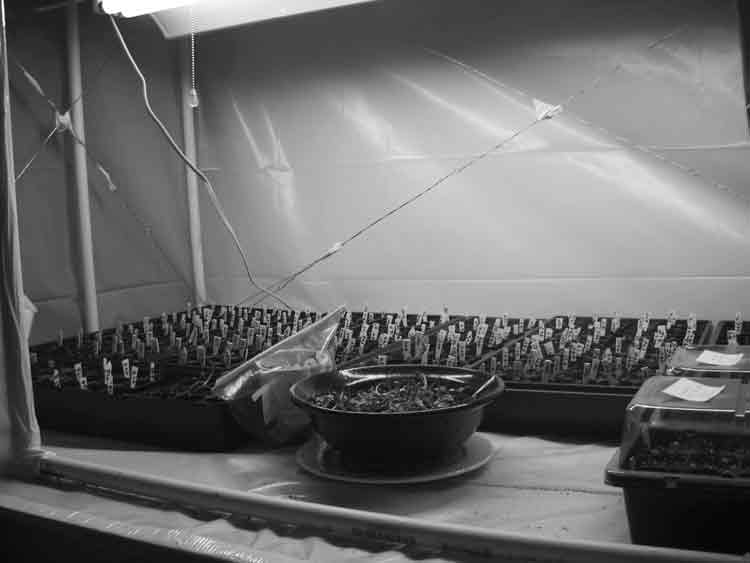JARS v64n2 - Can You Raise Rhododendrons in a Retirement Apartment?
Can You Raise Rhododendrons in a Retirement Apartment?
Tom Thomas
Mill Creek, Washington
Reprinted from the Cascade Chapter newsletter, January 2010

The following article is from our newest member, Tom Thomas, who lives in an apartment. He is very dedicated. Note in the picture that each square pot has its own label. He starts off with ten seeds per 16 cm 2 (four per sq. inch) in each pot in the flat, thins to four seedlings per pot; thins again about two months later to two seedlings per pot, and finally thins again about two months later to one seedling per pot. He transplants early to cause the least disturbance to the roots. The larger the transplant, the more roots, and thus the greater disturbance. These transplants are really really small. He has this down to a science and I hope you enjoy his article. He is inspirational! Also when he opened up his "green box," you could feel the heat escaping on your face - lots of light and heat. The door fits inside the structural piping, while the plastic fits outside which makes a good seal to hold moisture and heat in.
David Doherty, VPGreen Box for Rhodo Seedlings and Cuttings
In my apartment my gardening space is limited to windowsills. I sterilize my growing medium (peat) with a very dilute solution of potassium permanganate (pinch of crystals/litre or quart; see footnote for rational), and sowed seed from the ARS Seed Exchange on 9-8-09. My window sills proved to be a rather cool location for germination, but by 11-5-09, it was time for the first transplant, but to WHERE?WHERE turned out to be a table top in my study. For protection I covered the table with a plywood sheet cut to size by the lumber company, a size I could get into my car trunk. For waterproofing, I covered the plywood with plastic. On this I built my green box using 1.25 cm (½ in) PVC pipe for the frame, and covered it with plastic sheeting. The hardware store stocks pipe in 1.52 m (5 ft) lengths, a length I can carry in my car trunk, and further was of an optimum length for my construction with minimum waste. A 81 cm (32 in) high box allows 61 cm (24 in) from light bulb to plant, plus allowance for the dimensions of the light fixture and the plant containers. I used a shop light with ordinary 35 W light bulbs. (A different fixture might have been better, one to allow use of garden and aquarium bulbs). For this construction almost no tools were required. The parts were held together by glue, duct tape and wire. The pipe is cut to length with shears designed for the purpose ($US 10). The wire provides increased tensile rigidity to the structure (optional). (There is one drawback to this design - at times one must be very quick in fitting a number of glue joints together more or less simultaneously before the glue stiffens on any joint. Correction of error with PVC pipe is relatively easy - cut out the offending joint where the glue has hardened in the wrong position and use couplings to splice in the correct configuration. Dimensions: LWH= 152 x 86 x 81 cm (60 x 34 x 32 in). Area= 1.3 m 2 (14 ft 2 ) Volume = 1.07 m 3 (38 ft 3 ). Cost: $US 125.

|
|
Tom Thomas's "green box" for
rhododendron seedlings and cutting.
Photo by Tom Thomas |
Footnote: While there is much discussion on the Web about the use of potassium permanganate use in aquariums, etc., there is almost nothing about plant use. However, The Report of the Agricultural Experiment Station of Ithaca, N.Y., for 1919 contains a number of memoirs of considerable interest, especially from the botanical and entomological points of view. Work on the stimulation of growth by various chemical compounds indicates that treatment with potassium permanganate may result in a very marked increase in the root-growth of various woody cuttings." 1922. Nature 2734: 393.
